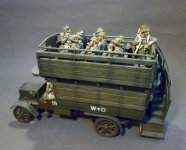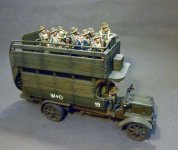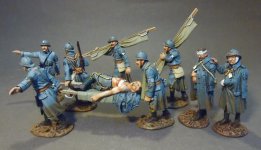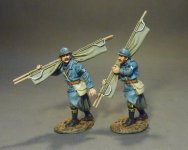You are using an out of date browser. It may not display this or other websites correctly.
You should upgrade or use an alternative browser.
You should upgrade or use an alternative browser.
New Releases For September 2015 - The Great War 1914-1918 (1 Viewer)
- Thread starter jjDesigns
- Start date
THE GALLIPOLI CAMPAIGN 1915
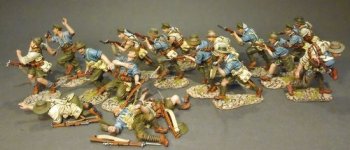
With World War I stalled on the Western Front by 1915, the Allied Powers were debating going on the offensive in another region of the conflict, rather than continuing with attacks in Belgium and France. Early that year, Russia’s Grand Duke Nicholas appealed to Britain for aid in confronting a Turkish invasion in the Caucasus. (The Ottoman Empire had entered World War I on the side of the Central Powers, Germany and Austria-Hungary, by November 1914.) In response, the Allies decided to launch a naval expedition to seize the Dardanelles Straits, a narrow passage connecting the Aegean Sea to the Sea of Marmara in northwestern Turkey. If successful, capture of the straits would allow the Allies to link up with the Russians in the Black Sea, where they could work together to knock Turkey out of the war.
The Gallipoli Campaign of 1915-16, also known as the Battle of Gallipoli or the Dardanelles Campaign, was an unsuccessful attempt by the Allied Powers to control the sea route from Europe to Russia during World War I. The campaign began with a failed naval attack by British and French ships on the Dardanelles Straits in February-March 1915 and continued with a major land invasion of the Gallipoli Peninsula on April 25, involving British and French troops as well as divisions of the Australian and New Zealand Army Corps (ANZAC). Lack of sufficient intelligence and knowledge of the terrain, along with a fierce Turkish resistance, hampered the success of the invasion. By mid-October, Allied forces had suffered heavy casualties and had made little headway from their initial landing sites. Evacuation began in December 1915, and was completed early the following January.
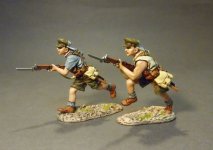
GLA-08
THE GREAT WAR, 1914-1918,
THE GALLIPOLI CAMPAIGN 1915,
ANZAC’S Charging,
(2pcs)
William Edward 'Billy' Sing, DCM (2 March 1886 – 19 May 1943) was a part Chinese/ Australian soldier who served in the Australian Imperial Force during World War I, best known as a sniper during the Gallipoli Campaign He took at least 150 confirmed kills during that campaign, and may have had over 200 kills in total. One contemporary estimate put his tally at close to 300 kills
A biography by John Hamilton, Gallipoli Sniper: The life of Billy Sing, was published in 2008.
Biographer John Hamilton described the Turkish terrain thus: "It is a country made for snipers. The Anzac and Turkish positions often overlooked each other. Each side sent out marksmen to hunt and stalk and snipe, to wait and shoot and kill, creeping with stealth through the green and brown shrubbery ...” Sing was partnered with spotters Ion 'Jack' Idriess and, later, Tom Sheehan. The spotter's task was to observe (spot) the surrounding terrain and alert the sniper to potential targets. Idriess described Sing as "a little chap, very dark, with a jet black moustache and goatee beard. A picturesque looking mankiller. He is the crack shot of the Anzacs.”
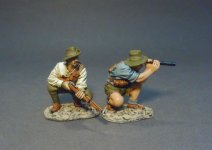
GLA-12
THE GREAT WAR, 1914-1918,
THE GALLIPOLI CAMPAIGN 1915,
“BILLY” SING, AND ION “JACK” IDRIESS,
(3pcs)
LIMITED EDITION 500
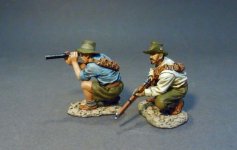
** PLEASE CONTACT YOUR LOCAL DEALER FOR FURTHER INFORMATION**
** PLEASE FEEL FREE TO ENTER THIS YEARS CAPTION CONTEST!**

With World War I stalled on the Western Front by 1915, the Allied Powers were debating going on the offensive in another region of the conflict, rather than continuing with attacks in Belgium and France. Early that year, Russia’s Grand Duke Nicholas appealed to Britain for aid in confronting a Turkish invasion in the Caucasus. (The Ottoman Empire had entered World War I on the side of the Central Powers, Germany and Austria-Hungary, by November 1914.) In response, the Allies decided to launch a naval expedition to seize the Dardanelles Straits, a narrow passage connecting the Aegean Sea to the Sea of Marmara in northwestern Turkey. If successful, capture of the straits would allow the Allies to link up with the Russians in the Black Sea, where they could work together to knock Turkey out of the war.
The Gallipoli Campaign of 1915-16, also known as the Battle of Gallipoli or the Dardanelles Campaign, was an unsuccessful attempt by the Allied Powers to control the sea route from Europe to Russia during World War I. The campaign began with a failed naval attack by British and French ships on the Dardanelles Straits in February-March 1915 and continued with a major land invasion of the Gallipoli Peninsula on April 25, involving British and French troops as well as divisions of the Australian and New Zealand Army Corps (ANZAC). Lack of sufficient intelligence and knowledge of the terrain, along with a fierce Turkish resistance, hampered the success of the invasion. By mid-October, Allied forces had suffered heavy casualties and had made little headway from their initial landing sites. Evacuation began in December 1915, and was completed early the following January.

GLA-08
THE GREAT WAR, 1914-1918,
THE GALLIPOLI CAMPAIGN 1915,
ANZAC’S Charging,
(2pcs)
William Edward 'Billy' Sing, DCM (2 March 1886 – 19 May 1943) was a part Chinese/ Australian soldier who served in the Australian Imperial Force during World War I, best known as a sniper during the Gallipoli Campaign He took at least 150 confirmed kills during that campaign, and may have had over 200 kills in total. One contemporary estimate put his tally at close to 300 kills
A biography by John Hamilton, Gallipoli Sniper: The life of Billy Sing, was published in 2008.
Biographer John Hamilton described the Turkish terrain thus: "It is a country made for snipers. The Anzac and Turkish positions often overlooked each other. Each side sent out marksmen to hunt and stalk and snipe, to wait and shoot and kill, creeping with stealth through the green and brown shrubbery ...” Sing was partnered with spotters Ion 'Jack' Idriess and, later, Tom Sheehan. The spotter's task was to observe (spot) the surrounding terrain and alert the sniper to potential targets. Idriess described Sing as "a little chap, very dark, with a jet black moustache and goatee beard. A picturesque looking mankiller. He is the crack shot of the Anzacs.”

GLA-12
THE GREAT WAR, 1914-1918,
THE GALLIPOLI CAMPAIGN 1915,
“BILLY” SING, AND ION “JACK” IDRIESS,
(3pcs)
LIMITED EDITION 500

** PLEASE CONTACT YOUR LOCAL DEALER FOR FURTHER INFORMATION**
** PLEASE FEEL FREE TO ENTER THIS YEARS CAPTION CONTEST!**
mikemiller1955
Lieutenant General
- Joined
- Aug 3, 2008
- Messages
- 17,578
I like the French and will be getting those to go with my K&C French.
Very nice figures indeed!
likewise...I'm getting the French stretcher bearers too...
mestell
Colonel
- Joined
- Feb 12, 2008
- Messages
- 9,074
likewise...I'm getting the French stretcher bearers too...
Ditto . . . .
:smile2: Mike
villagehorse
Lieutenant General
- Joined
- Feb 5, 2010
- Messages
- 16,446
Ditto . . . .
:smile2: Mike
Ditto. Robin.
chalklands
Sergeant First Class
- Joined
- Aug 2, 2007
- Messages
- 1,198
likewise...I'm getting the French stretcher bearers too...
Ditto^&grin^&grin
Pete
Users who are viewing this thread
Total: 2 (members: 0, guests: 2)


